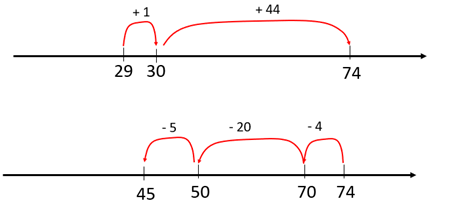Purpose
The purpose of this activity is to support students using their knowledge of place value to solve difference problems with two-digit numbers, with renaming.
Achievement Objectives
NA2-1: Use simple additive strategies with whole numbers and fractions.
Required Resource Materials
- Place value materials: individual items grouped into tens, such as BeaNZ in film canisters, iceblock sticks bundled with rubber bands (hundreds with hair ties), or a paper form such as Place Value People. Bundled materials are important as they allow partitioning and combining without the need for “trading” tens blocks for ones.
- A place value board can be used to organise the materials in columns and support calculation strategies. Three-column and four-column place value boards are available here.
Activity
- Pose difference problems with two-digit whole numbers in which the ones digit of the larger number is less than the ones digit of the smaller number. For example:
You have 32 ice block sticks and I have 18 ice block sticks.
How many more ice block sticks do you have than I have?
- Provide time for students to work out the difference independently, without using physical models. If your students demonstrate place value misunderstandings, create models with bundled place value materials arranged on a place value board to support their thinking.
- After a suitable amount of time, gather together to discuss the two main ways of solving the problem - addition and subtraction - and the efficiency of each strategy. Te reo Māori kupu such as tāpiri (add), tango (subtract), and huantango (difference) could be used throughout this learning.
Who solved the problem by adding?
Who solved the problem by subtracting or "taking away"?
Which strategy, adding on or subtracting, was the easiest to do? Why?
If needed, model each strategy (or get students to) for the class.
In this case addition and subtraction are similar because both involve acts of renaming.
- Adding on from 18 to get to 32. This strategy can be represented by an empty number line.

- Subtracting 18 from 32. This strategy can also be represented on an empty number line or as a vertical written algorithm. Note that the latter strategy might demonstrate procedural knowledge, rather than an understanding of place value.


- Pose other similar problems in which the amount of difference is extended. Encourage students to use their number facts and place value knowledge to solve each problem. For example:
You have 74 ice block sticks and I have 29 ice block sticks.
How many more ice block sticks do you have than I have?
Which strategy is easier, adding on or subtracting?
If needed, support students' recognition of place value by making the quantities with bundles of materials and arranging them vertically on a place value board. Gradually mask the materials to support greater reliance on symbolic recording and mental or written strategies.

Addition might be considered more efficient because the renaming is easier. Students might also find easier subtraction strategies such as 74 – 30 = 44, 44 + 1 = 45.
- Provide examples with a focus on finding the answer, using accurate and systematic recording strategies (e.g. a number line), and on using the most efficient method. You might group students to encourage scaffolding, extension, and productive learning conversations. Ensure students have opportunities to share their understanding, ask questions, and listen to a variety of ideas in a variety of groupings.
- Subtraction is more efficient:
You have 93 ice block sticks and I have 17 ice block sticks.
How many more ice block sticks do you have than I have?
93 - 20 = 73, 73 + 3 = 76 is very efficient.
- Addition and subtraction are equally efficient:
You have 84 ice block sticks and I have 78 ice block sticks.
How many more ice block sticks do you have than I have?
Record the possible strategies symbolically.
78 + [ ] = 84
84 - 78 = [ ]
- Subtraction is more efficient:
Next steps for further learning
- Increase the level of abstraction to the point where students can work with symbols without the need for physical models. Develop their fluency with recording strategies as addition or subtraction equations, in horizontal or vertical form. For example, the difference between 61 and 18 can be found using 61 - 18 = [ ] and 18 + [ ] = 61 or
 .
.
- Change the questions to include the word “fewer”. For example, “you have 76 counters and I have 29 counters. How many fewer dinosaurs do I have compared to you?”
A suggested sequence for extending the difficulty of finding differences is:
- Use smaller differences, such as between 41 and 27.
- Use larger differences, such as between 96 and 28.
Add to plan
Level Two